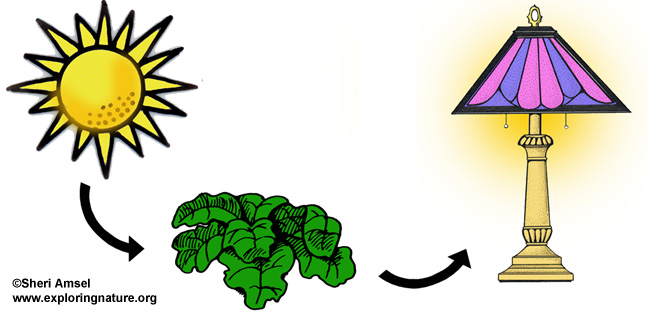

Scientific Phenomena
Photosynthesis is how plants make food. They take the light from the sun and change it into sugars that they use for energy, growth and repair. They collect the light using special proteins in their chlorophyll. Scientists at MIT have invented a way to make those photosynthetic proteins collect light and instead of making it into sugars, they make it into electricity.
They had to find a way to protect the electrodes from the water and salt that the photosynthetic proteins needed to survive. So they created tiny peptide molecules that would wrap around the photosynthetic proteins like a fish tank keeping them wet and working, while the electrodes stayed dry.
So far, the electrical current they made is weak, but building on this new technology, eventually they hope to make enough power to fuel solar cells for computers and cell phones and well -- anything that can sit out in the sun! (Epstein, David. "Will Your Next Computer Be Powered by Spinach?" Discover January 2005: p. 69)
Off site resource from Discover: http://discovermagazine.com/2005/jan/computer-powered-by-spinach
Now researchers at Technion-Israel Institute of Technology have developed a bio-photo-electro-chemical (BPEC) cell using the a membrane extract from spinach leaves to produce electricity with a hydrogen byproduct. This allows the production of electricity with no combustion and so no carbon dioxide or orther greenhouse gases as a by-product.
(American Technion Society. "Popeye was right: There’s energy in that spinach." ScienceDaily. ScienceDaily, 22 September 2016.)
Off site resource Science Daily: https://www.sciencedaily.com/releases/2016/09/160922085743.htm
Essential Questions
1. Can we generate electricity from plants?
Disciplinary Core Ideas
PS3.D: Energy in Chemical Processes and Everyday Life: LINK
The chemical reaction by which plants produce complex food molecules (sugars) requires an energy input (i.e., from sunlight) to occur. In this reaction, carbon dioxide and water combine to form carbon-based organic molecules and release oxygen. (secondary to MS-LS1-6)
Science and Engineering Practices
Developing and Using Models
Modeling in 6–8 builds on K–5 experiences and progresses to developing, using, and revising models to describe, test, and predict more abstract phenomena and design systems.
• Develop and use a model to describe phenomena. (MS-LS1-2)
• Develop a model to describe unobservable mechanisms. (MS-LS1-7)
Planning and Carrying Out Investigations
Planning and carrying out investigations in 6-8 builds on K-5 experiences and progresses to include investigations that use multiple variables and provide evidence to support explanations or solutions.
• Conduct an investigation to produce data to serve as the basis for evidence that meet the goals of an investigation. (MS-LS1-1)
Constructing Explanations and Designing Solutions: Apply scientific ideas to construct an explanation for real-world phenomena, examples, or events.
Obtaining, Evaluating, and Communicating Information: Gather, read, and synthesize information from multiple appropriate sources and assess the credibility, accuracy, and possible bias of each publication and methods used, and describe how they are supported or not supported by evidence.
Crosscutting Concepts
Cause and Effect: Phenomena may have more than one cause, and some cause and effect relationships in systems can only be described using probability.
Systems and System Models
• Systems may interact with other systems; they may have sub-systems and be a part of larger complex systems. (MS-LS1-3)
Energy and Matter
• Matter is conserved because atoms are conserved in physical and chemical processes. (MS-LS1-7)
• Within a natural system, the transfer of energy drives the motion and/or cycling of matter. (MS-LS1-6)
Structure and Function
• Complex and microscopic structures and systems can be visualized, modeled, and used to describe how their function depends on the relationships among its parts, therefore complex natural structures/systems can be analyzed to determine how they function. (MS-LS1-2)
Other questions that were generated in researching this Scientific Phenomena?
______________________________________________________________________________
Using Discoveries and Inventions as Scientific Phenomena to Integrate with NGSS:
______________________________________________________________________________
Scientific Phenomena can be used as a tool to anchor a science unit involving a series of lessons to engage in deeper science learning – or what is being called “Three Dimensional Learning”.
1) Describe the phenomena in a way that your students can understand and which sparks their imagination.
2) Create Essential Questions for them to answer to explain the phenomena.
3) Identify the NGSS Disciplinary Core Ideas which you are targeting.
4) Provide clear directions for a process they should use to try to answer the questions using the NGSS Science and Engineering Practices to frame as your guideline.
5) Name the Crosscutting Concepts that students should be aware of throughout the lesson.
6) Discuss the Connections to Nature of Science.
7) Make note of other questions generated in the process of exploring this Scientific Phenomena.
